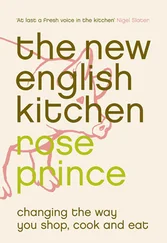Seasonal meat and dairy produce
While most fresh meat and cheeses are now available all year round, there are still a few festive and traditional specialities that have a short season. Lamb deserves special attention. We could reduce our dependence on imports of New Zealand lamb by tapping into the supplies of the light ‘upland’ lamb and mutton available direct from farms and traditional butchers throughout the autumn and winter.
SEASONAL CHART
UK-GROWN VEGETABLES AND FRUIT
Apples (August to March)
Asparagus (May to June)
Aubergine (May to September)
Cabbages (all year round)
Carrots (June to April)
Cauliflowers (all year round)
Celeriac (October to February)
Cherries (June to July)
Courgettes (June to October)
Cucumber (February to September)
Curly kale (all year round)
Farmed blackberries (July to October or until the first frost)
Fenland celery (November to January)
Fennel (May to October)
Forced rhubarb (December to March)
French beans (July to October)
Fresh herbs (April to November)
Garlic (August to December)
Gooseberries (June to July)
Grapes (September to October)
Green celery (March to November)
Jersey Royal and Cornish Early new potatoes (February to June)
Jerusalem artichokes (October to March)
Kentish cobnuts (September to October)
Leeks (August to April)
Lettuce and salad leaves (January to November)
Mangetout (May to September)
Marrows (August to October)
Morels (March to April)
Mushrooms (all year round)
New potatoes (May to September)
Onions (July to May)
Oyster mushrooms (May to June)
Parsnips (July to March)
Pea shoots (May to August)
Pears (September to April)
Peas (June to September)
Plums (August to September)
Potatoes (all year round)
Puffballs, chanterelles, ceps, fairy ring and other wild mushrooms (September to October)
Pumpkin and squash (September to February)
Purple sprouting broccoli (November to April)
Quince (September to October)
Radishes (January to November)
Raspberries (June to October or until the first frost)
Red, white and black currants (July to August)
Runner beans (August to November)
Seakale (January to February/March)
Sloes (September)
Spinach (all year round)
Stinging nettles (March to April)
Strawberries (April to October or until the first frost)
Summer rhubarb (April to October)
Swede (November to March)
Sweet chestnuts (October to January)
Sweetcorn (August to October)
Tomatoes (February to December)
Turnips (July to April)
Walnuts (October)
Watercress (February to November but can run on in a frost-free winter)
Wild blackberries (August to October)
Wild garlic (March to May)
Anchovies (September to May)
Brill (October to May)
Brown crab (February to November)
Brown shrimp (February to October)
Brown trout (March to October)
Cockles (September to May)
Cod, line-caught from Bristol and English Channel (May to January)
Dover sole (August to May)
Gilthead bream (January to October)
Haddock (August to February)
John Dory (May to February)
Langoustines/Dublin Bay prawns (October to April)
Lemon sole (September to March)
Lobster (April to September)
Mackerel from Bristol and English Channel (August to February)
Megrim sole (May to December)
Monkfish (July to March)
Native oysters (September to April)
Plaice (April to December)
Red gurnard (September to April)
Red mullet (August to April)
Sardines/pilchards (August to March)
Sea bass (July to February)
Sea bream (June)
Sea trout (April to October)
Spider crab (August to March)
Sprats (September to April)
Squid (April to November)
Turbot (September to March)
Venus clams (July to April)
Whelks (February to August)
Whiting (May to February)
Wild Atlantic salmon (February to October)
Witch (October to April)
Christmas goose (December)
Christmas turkey (December)
Light lamb or hill lamb (September to December)
Michaelmas goose (September)
Milk-fed lamb (March)
Native grass-fed beef (December)
Salt marsh lamb (July)
Spring lamb (March)
Suckling pig (December)
Black game (12th August to 10th December)
Capercaillie (1st October to 31st January)
English and Welsh hind (doe) venison, red, fallow, roe and sika (1st November to 30th April)
English and Welsh red stag venison (1st August to 30th April)
English and Welsh roebuck venison (1st April to 31st October)
Grouse (12th August to 10th December)
Hare (August to February)
Mallard and other wildfowl (1st September to 31st January)
Partridge (1st September to 31st January)
Pheasant (1st October to 31st January)
Scottish fallow stag (buck) venison (1st August to 30th April)
Scottish hind (or doe) venison, red, fallow and sika (21st October to 15th February)
Scottish red and sika stag venison (1st July to 20th October)
Scottish roe doe venison (21st October to 31st March)
Scottish roebuck venison (1st April to 20th October)
Snipe (1st September to 31st January)
Woodcock (1st September to 31st January)
Eating apples should feel only good but now presents the conscientious shopper with myriad anxieties. On the one hand, eating fruit, any fruit, is undeniably beneficial to health; and an apple is a definite candidate for the recommended five-a-day the Food Standards Agency asks consumers to eat. But with reports that this perishable orchard fruit could be contaminated with agricultural chemicals, or that the crunchy southern hemisphere varieties snapped up eagerly by British shoppers have gobbled up an astonishing number of food miles, that oh-so-good-for-you apple can stick in your throat. Then there’s the question of which apple to buy, given no ready British supply. For some, preference for, perhaps, US fruit over French, or New Zealand over Chilean, comes down to old and new loyalties; a case where the wallet becomes a voting slip.
Are there chemical residues on apples?
Yes. First, be aware that while it is in the interests of supermarkets to control the level of pesticide and post-harvest fungicide drenches applied to apples from the ‘dedicated’ British farms that supply them, they are less able to monitor all imports. In 2005 the government-backed Pesticides Residues Committee sampled 63 apples, finding chemical residues on all but seven. No residues were found on the four organic samples taken. Residues were found on all EU-originated apple samples. Two samples contained residues at levels unacceptably high for children. Many apples are waxed to protect them and enhance their appearance; this wax may contain fungicides, so wipe off as much as possible before eating. Concerned parents should peel imported apples before giving them to children.
Are organic apples the right choice?
Not always. Organic apples from supermarkets, organic food shops and even box schemes are often imported, and the food miles they clock up negate any environmental gain. Buying British-grown organic apples is ideal but you will have to look hard for them. Growing a disease-free, good-looking apple without pesticides is a tough task in the British climate. Old trees that have never been treated with agricultural chemicals tend to produce abundantly without problems, but organic farmers say that new orchards can develop disease/pest problems after just a few years, which are very hard to control.
Читать дальше












